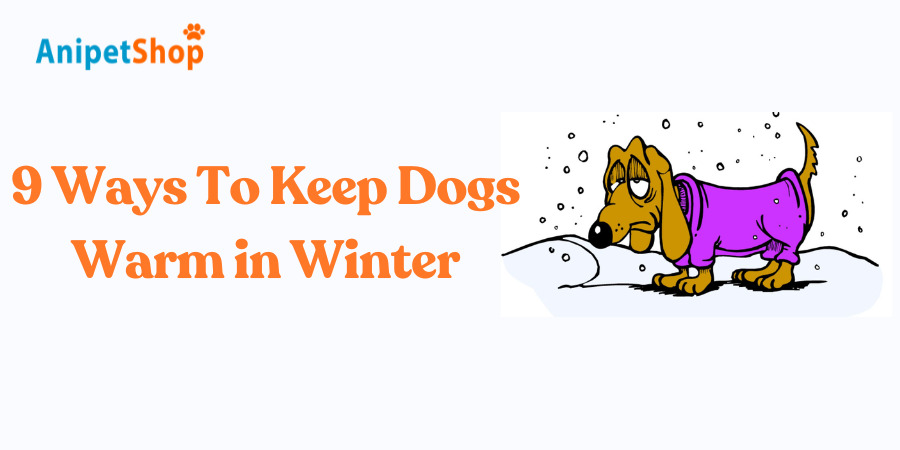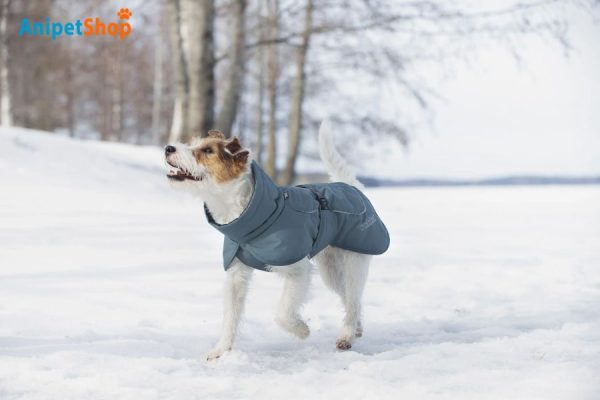9 Ways To Keep Dogs Warm in Winter
Winter can have significant effects on dogs, influencing their health and well-being in various ways. A study published in the “Journal of Veterinary Internal Medicine” claims that cold weather can lead to cold stress and hypothermia in dogs, especially those with thin fur, small body size, or health issues. It is also found that hypothermia in dogs can occur when their core body temperature drops below 35°C (95°F). The risk increases with prolonged exposure to temperatures below 7°C (45°F). Hence, pet owners should be aware of these effects and find suitable ways to keep their pets warm. This article will explore 9 salient methods to protect your beloved dogs during the cold season.

#1. Invest in a warm dog coat or sweater
Investing in a warm dog coat or sweater is essential, especially for breeds with thin fur, small sizes, or those more susceptible to cold. A well-fitted coat ensures optimal warmth and comfort, preventing hypothermia and maintaining a dog’s body temperature. Moreover, dog boots are crucial for protecting paws from the harsh winter elements. They shield against cold, ice, and harmful de-icing chemicals, preventing injuries and discomfort, and allowing your dog to enjoy outdoor activities safely during winter.

#2. Provide a cozy bed or blanket
Providing a cozy bed or blanket for your dog has numerous benefits, especially during the winter months. One of which is that a warm, comfortable bed placed away from drafts helps maintain your dog’s body temperature and ensures they stay warm and secure. Besides, adding blankets can enhance warmth, offering an extra layer of insulation against the cold. Self-warming beds are an excellent option, as they reflect the dog’s body heat, creating a snug and toasty resting place without the need for electricity. Ensuring your dog has a dedicated, warm spot to sleep promotes better rest and overall well-being during the colder season.

#3. Groom regularly, but don’t shave
Regular grooming, particularly brushing, plays a crucial role in maintaining a dog’s coat during winter. Brushing helps to remove loose fur and dirt, preventing matting and allowing the coat to retain its insulating properties. This ensures better air circulation within the fur, which helps in trapping heat and keeping the dog warm. However, it’s important not to shave a dog’s fur short in winter. A dog’s coat serves as natural insulation against both cold and heat, and shaving it can disrupt this insulation, leaving the dog vulnerable to temperature extremes. Instead, regular grooming sessions should focus on keeping the coat clean, healthy, and adequately insulated for the winter months.

#4. Watch for heat-seeking behavior
Watching for heat-seeking behavior in dogs is crucial during colder months as it can indicate they need additional warmth. If a dog frequently seeks out warm spots like sunny patches or near heaters, it suggests they may feel cold. In response, pet owners should consider adjusting their bedding by adding extra blankets or providing a warm, cozy bed away from drafts. Additionally, investing in a well-fitted coat or sweater can help maintain their body temperature when they are outdoors. Monitoring and responding to heat-seeking behavior ensures that dogs remain comfortable and protected from the cold during winter.

#5. Watch out for signs of arthritis
During winter, some dogs, especially those with arthritis, may exhibit signs such as stiffness or reluctance to move. This is because cold weather can exacerbate joint pain. To help manage this, dogs may require slightly more food to support their energy needs for maintaining body warmth and mobility. However, it’s crucial to consult a veterinarian before making any dietary changes. A vet can assess the dog’s condition, recommend appropriate adjustments based on their health and activity level, and ensure that any dietary modifications support overall well-being without compromising their health. This proactive approach ensures that dogs with arthritis receive optimal care and support throughout the winter months.

#6. Adjust feeding
Adjusting feeding for dogs during winter is crucial to help them stay warm and maintain their energy levels. Cold weather increases dogs’ energy requirements as they expend more calories to regulate body temperature. Pet owners should consider slightly increasing their dog’s food intake, particularly if they spend more time outdoors or are active in cold weather. Furthermore, it’s essential to regularly wipe and check their paws after walks to remove ice, snow, and potentially harmful chemicals like de-icers. Using a paw balm can further protect their paws from cracking, dryness, and irritation caused by cold temperatures and salted surfaces. These measures not only help dogs stay comfortable but also ensure their overall health and well-being during the winter season.

#7. Limit time outdoors in extreme cold
The low temperatures can cause muscles to tighten and joints to become more painful and inflamed. Pet owners should monitor their dog’s behavior closely for signs of discomfort during winter outings and consider shortening outdoor activities when temperatures drop significantly. It’s advisable to consult with a veterinarian about pain management options if arthritis symptoms worsen in cold weather. Vets can recommend appropriate medications, supplements, or therapies to help alleviate pain and improve the dog’s comfort and mobility during the winter months. By taking these precautions, pet owners can ensure their dogs with arthritis receive the necessary care and support to minimize discomfort in cold weather.

#8. Protect and inspect your dog’s paws
It’s advisable to keep walks short and prioritize quick potty breaks over extended play sessions outdoors. Cold surfaces, such as snow and ice, can cause discomfort and potential injury to a dog’s paws. After each walk, carefully inspect their paws for any signs of cracking, irritation, or buildup of ice and snow between the toes. Wiping their paws with a damp cloth can help remove any residue and prevent irritation from salt or chemical de-icers used on roads and sidewalks. Additionally, using paw balms or protective booties can provide an extra layer of insulation and shield against harsh winter elements, ensuring your dog’s paws remain healthy and comfortable throughout the season.

#9 Know the signs of hypothermia
Here are some popular signs of hypothermia in dogs:
- Shivering: Uncontrollable shaking or trembling, especially if the dog is unable to stop even when warmed.
- Lethargy: Unusual tiredness or lack of energy, where the dog seems unusually slow or reluctant to move.
- Weakness: Declined strength or difficulty standing or walking.
- Confusion: Disorientation or altered mental state, where the dog may appear dazed or have difficulty responding to commands.
If any of these signs of hypothermia are observed in a dog, immediate action is crucial. Pet owners should bring their dogs indoors to a warm, dry area and wrap them in blankets or towels to gradually raise their body temperature. It’s essential to avoid using direct heat sources like heating pads or hair dryers, as these can cause burns. Instead, gentle warming methods such as covering the dog with warm blankets and providing a warm environment are recommended. In addition, seek veterinary care promptly to assess and treat any potential complications from hypothermia. Early intervention is key to ensuring the dog’s safety and recovery from hypothermia.

FAQs
How do I know when it is too cold for my dog?
You can realize it is too cold for your dog if they show signs of discomfort or distress. ou should notice when they are shivering, reluctant to go outside, lifting their paws off the ground, or seeking warm spots. Dogs with short fur, small breeds, or those with health conditions are more sensitive to cold. If temperatures are near or below freezing, it’s safer to limit outdoor time and ensure they have warm shelter indoors.
How can I keep my dog warm outside?
To keep your dog warm outdoors, consider these tips:
- Provide shelter: Ensure your dog has access to a dry, draft-free shelter with bedding that retains warmth.
- Clothing: Use a well-fitted coat or sweater to provide extra insulation, especially for short-haired or small breeds.
- Limit exposure: Keep outdoor time short in cold weather and avoid icy or snowy conditions that can harm their paws.
- Paw protection: Use booties or paw balm to protect their paws from cold surfaces and harmful chemicals like de-icers.
- Check frequently: Monitor your dog for signs of discomfort or cold-related issues, and adjust their environment accordingly.
By taking these precautions, you can help ensure your dog stays warm and comfortable during outdoor activities in colder weather.
Lily Watson is an author specializing in veterinary care in Australia. With a profound passion for animal welfare and a solid foundation in veterinary science, Lily has dedicated herself to disseminating valuable knowledge and information for both pet owners and professionals in this field.

